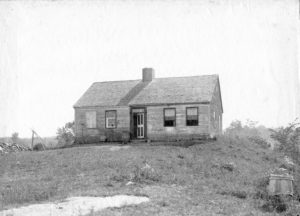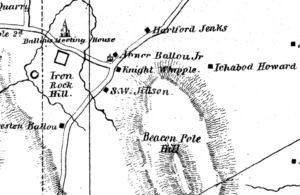Obadiah Ballou (1689-1768)

Probable location on 1838 map: Knight Whipple house, on the east where Elder Ballou Meeting House Road intersects West Wrentham Road.

Adin Ballou, writing in the 1880’s, wrote: “His (Obadiah’s) domicile is said to have stood on the easterly side of the road nearly opposite Iron Rock Hill, and less than one fourth of a mile southeasterly from that of James” (which is the Abner Ballou, Jr. house on the map).
“Several years previous to 1828, the old frame house built by Obadiah on that site, had become much dilapidated, and was known in the neighborhood as the “Sprague house.” The writer recollects it well, and that a rumor prevailed, at one time, of its being haunted by the ghost of an occupant who had been carried home drunk on a plank and dropped on the floor abruptly, to die uncared for. Facts not investigated. Knight Whipple, whose wife was a gt. gd. (great-granddaughter) of Obadiah, came into the premises and demolished the old “Sprague house” in 1817. In 1828 or thereabouts, he built the small one-story dwelling now occupying that same site.” [1]
Obadiah was one of the three Ballou brothers who originally moved to the Cumberland area. Their father, James, son of Maturin, who lived near present-day Albion, acquired a large tract of land and divided it between his sons James, Nathaniel, and Obadiah.
Obadiah Ballou donated the land for the Elder Ballou Cemetery in 1749. “Excepting about half one acre of land at the north end of the first mentioned tract or homestead farm, which is, and I hereby do except it, for a Burying Place for myself and my friends and neighbors, “ from the gift-deed from Obadiah to his son Abner. [2]
Obadiah’s portion included Iron Rock Hill. In June 1733, Obadiah Ballou conveyed to Caleb Barker and Matthew Estes of Hanover, in Plymouth County, MA, “all of the iron stone on his land that they should make use of, for one shilling per ton; they agreeing to build, at some convenient place near the hill containing the rock, a furnace for smelting said iron stone”.[3]
Adin Ballou believed that the nearest furnace was Unity Furnace in Manville, which was a little more than two miles south of Iron Rock Hill. (By 1740, for various reasons the mineral rights had been returned to Obadiah.)
Iron Rock Hill /Iron Mine Hill
“Iron Rock Hill is a natural curiosity; …On the northeast it is precipitous, with a rough gulch at its base; northerly it slopes off gently into flat land; and westerly it descends somewhat steeply, but without abruptness, to Iron Rock Meadow. It is largely composed of what may be called solid iron-rock, in ledge structure or some isolated boulders of moderate size–mainly in ledge form. The iron is amalgamated with some kind of granitic substance, in the proportion of from fifty to eighty per cent. iron. The iron is of an excellent quality, of unusual tenacity, and more or less magnetic, at least in some parts of the hill. This unique geological elevation is quite unlike any other deposit of iron within hundreds of miles around. Some unaccountable volcanic freak, in the remote past, must have thrown it up from the depths below. Large quantities of this rocky ore have been carried away, first and last, to different furnaces.” [4]
According to “The Historic and Architectural Resources of Cumberland, RI” by the RIHPHC, Iron Mine Hill has been reduced to approximately half its size by extensive mining and quarrying, although “titanium in the ore from Iron Mine Hill made it extremely refractory, and thus hard to smelt.” It was mined for trap rock for road building in the early 20th century.
Iron Mine Hill also includes the world’s only deposit of cumberlandite. [5]
- “The Elaborate History”, p. 46
- Ibid, p. 47
- Ibid, pp. 45-46.
- Adin Ballou, “The Elaborate History”, p. 45
- “The Historic and Architectural Resources of Cumberland, RI”, RIHPHC, rev. 1998. pp. 2, 8, 45.